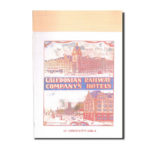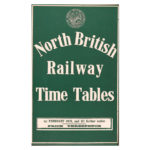Description
Volume 3:
Glasgow & South Western
Caledonian
North British
Highland
Great North of Scotland
Ernest Leopold Ahrons (1866 – 1926), was educated at the Bradford Grammar School and Yorkshire College, Leeds. As a student at the latter he obtained one out of three advanced scholarships in mathematics and physics, and was awarded first prize in engineering construction and mechanism and machinery. Leaving college in 1885, Ahrons went as a pupil under Mr. W. Dean to Swindon Locomotive Works, Great Western Railway, until 1888, and for two years after was employed in the Drawing Office and as an inspector of materials. In 1890 he became Chief Draughtsman to Messrs. Fleming, Macfarlane & Co., of Middleton, and soon afterwards obtained a position on the drawing office staff of Messrs. Beyer, Peacock & Co. Ltd. He was appointed in 1892 to the position of Engineer and Manager of the Government Workshops attached to the Ecole Khédivial d’Arts et Métiers, at Boulac, Cairo. Owing to ill health, he resigned this appointment in 1898, and returned to England. In the same year he became engineer-in-charge of the general department of Messrs. Henry Simon Ltd., of Manchester. Between the years 1902 and 1917 he held various positions in engineering industry, and during the Great War acted as a Trade Officer at the Department of Overseas Trade (Development and Intelligence). He resigned from the Government service in 1919, and until his death devoted himself entirely to literary work.
LOCOMOTIVE & TRAIN WORKING… is by far the best body of published work describing what rail travel was like in the second half of Victoria´s Reign. Ahrons did time trains as a passenger, but unlike C.J. Allen, O.S. Nock and later, P.W.B. Semmens,did not pad out his work with practically signal box by signal box passing times, confining himself basically to departure and arrival times, commenting “late”, “on time” or “early”. The type of detailed log described is virtually meaningless without details of weather throughout the journey, was the train half full, full “full and standing?”; what recovery time was privately allowed in the Working Timetable?; what did the guard´s journal for the run have to report over delays caused by large numbers of passengers leaving or joining, GPO loading or unloading mail, or the railway’s own parcel and luggage traffic?Also unlike the “professional” train timers, Ahrons did not feel the need to avoid criticism of the railway, for fear of not being granted footplate trips and free passes. He was a keen observer, not just of locomotives but also of passenger carriages and of stations. His style, although not quite as entertaining as Hamilton Ellis, nonetheless is readable, and betrays a dry sense of humour. .
This is what he had to say about the Great North of Scotland railway ”Once upon a time, this was a shocking railway, A really very shocking railway, Why it was ever allowed to be called a railway at all, passed comprehension. As a matter of fact, part of it between Inverurie and Aberdeen was originally not a railway at all, but a canal and the Company scooped in the canal, bailed it out, and made their line on the remains. After which, some people in that district, bethought themselves when it was too late, that the canal would have been infinitely preferable”.
The remaining volumes in this series will be offered in due course. Please check in the “SEARCH PRODUCTS” BOX













Reviews
There are no reviews yet.